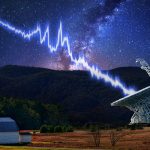
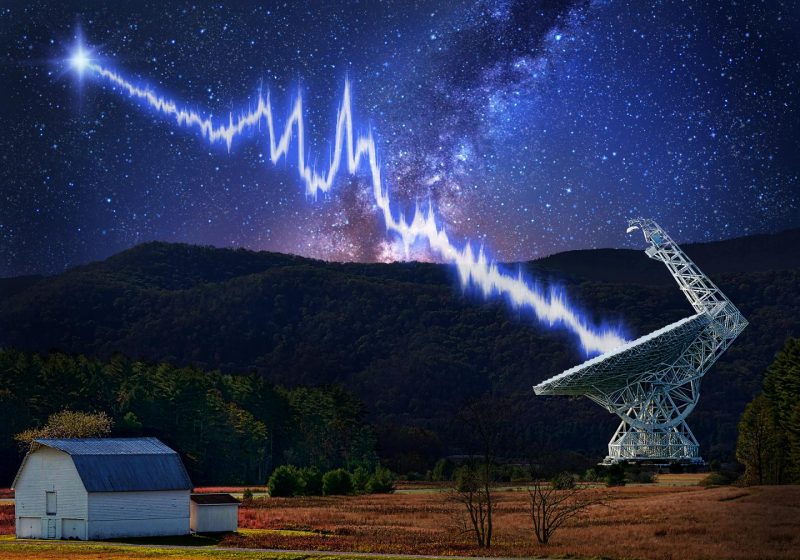
The Green Bank Telescope in West Virginia is one of the telescopes used by Breakthrough Listen for SETI. Here, an artist has portrayed a signal from a Fast Radio Burst – or FRB – detected by the telescope. FRBs are one of the sorts of objects on the new Breakthrough Listen Exotica list. Image via UC Berkeley.
Are we alone in the universe? That’s one of the biggest, still unanswered questions facing humankind. Now, the Breakthrough Listen initiative has announced the release of a comprehensive Exotica catalog, listing over 700 objects and phenomena in the known universe of potential interest to scientists searching for technosignatures, that is, evidence of extraterrestrial intelligence beyond just the radio signals focused upon in traditional SETI.
Breakthrough Listen says the targets listed in its Exotica catalog will also be useful for the study of astrophysics in general.
A new paper detailing the creation of the list – officially called The Breakthrough Listen Exotic Target Catalog, or Exotica Catalog – was published as a preprint at arXiv on June 23, 2020.
As explained by Breakthrough Listen:
Breakthrough Listen to date has largely focused on the search for ‘life as we know it’ – including Earth-like planets around sun-like stars such as Kepler 160. But what if extraterrestrial intelligences are not like us, but are found in the frigid reaches of the outer solar system, the extreme gravity of neutron stars, the brilliant cores of active galaxies, or the hearts of the richest galaxy clusters? Now we’re announcing an expanded approach, targeting ‘one of everything’ in the universe.
The new Exotica Catalog includes over 700 distinct objects. It has an example of each type in our Prototype sample, extreme objects with record-breaking properties in our Superlative sample, and lingering mysteries in our Anomaly sample. A small Control sample rounds out the list with sky locations we do not expect to be special as a comparison.
With the Exotica catalog, we aim to answer many questions. Have we been looking in the wrong places? Might a few of the objects we think are natural actually be artificial? Could some natural phenomenon or problem with our instruments fool us into thinking we are looking at a signal from an intelligence? What can we learn by using the unique Breakthrough Listen backend to observe the natural world?
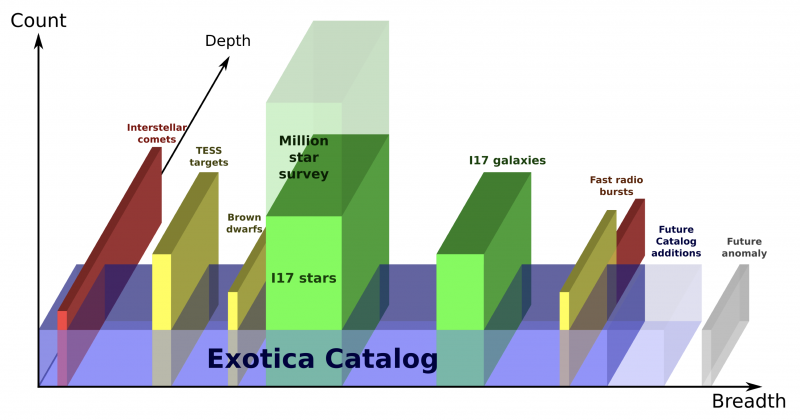
Graph depicting what kinds of target selections are included in the catalog. Image via Lacki et al./ arXiv.
The intention of the catalog is to include “one of everything” in the observable universe. It is the first catalog in recent years to cover the entire vast array of exotic phenomena, from distant galaxies to objects in our own solar system. The idea is that it will serve as a guide for researchers searching for evidence of extraterrestrial life, as well as studying natural astrophysical phenomena. Brian Lacki, a graduate student at Ohio State University and lead author of the new catalog, said in a statement:
Many discoveries in astronomy were not planned. Sometimes a major new discovery was missed when nobody was looking in the right place, because they believed nothing could be found there. This happened with exoplanets, which might have been detected before the 1990s if astronomers looked for solar systems very different than ours. Are we looking in the wrong places for technosignatures? The Exotica Catalog will help us answer that question.
The catalog is not just limited to SETI, though. My hope is that any program with a new capability may use the Exotica catalog as a shakedown cruise around the universe.

Artist’s concept of a Dyson sphere megastructure, one type of hypothesized alien technosignature. Image via SentientDevelopments.com.
While the catalog has over 700 listings, those listings are grouped into four main categories:
- Prototypes: a list containing at least one example of every known kind of celestial object (apart from those too transient to present realistic observation targets). Planets and moons, stars at every point of their life cycle, galaxies big and small, serene star clusters and blazing quasars, and more are all included in the list.
- Superlatives: objects with the most extreme properties. These include examples like the hottest planet, stars with unusually high or low metal content, the most distant quasar and fastest-spinning pulsar, and the densest galaxy.
- Anomalies: enigmatic targets whose behavior is currently not satisfactorily explained. For instance, the famous “Tabby’s Star” with its bizarre dimming behavior; ’Oumuamua, the interstellar object that passed near Earth in 2017; unexplained optical pulses that last mere nanoseconds; and stars with excess infrared radiation that could conceivably be explained as waste heat from alien megastructures.
- Control sample: a list of sources not expected to produce positive results.
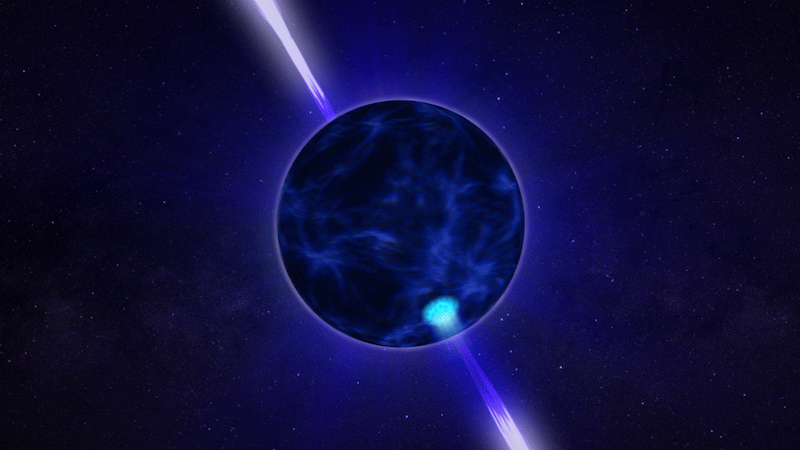
Artist’s concept of a pulsar. When pulsars were first discovered, it was thought they might be artificial beacons, but they turned out to be a natural phenomenon. The new catalog will help to better differentiate between natural phenomena and actual artificial artifacts. Image via NASA/ Goddard Space Flight Center.
There is also a new classification system for anomalies and new plans for observations of some of these objects based on the catalog.
This catalog is an innovative and welcome addition to the overall SETI effort, as it broadens the focus to many other celestial objects and phenomena, while traditional SETI tended to search only for radio signals, and more recently, light or laser signals. Technosignatures are the new big thing in the search for intelligent extraterrestrial life. But even the search for those until now has focused primarily on looking for evidence of “life as we know it” around nearby stars. According to Andrew Siemion, leader of the Breakthrough Listen science team:
Technosignature searches to date have largely focused on the search for ‘life as we know it’: nearby stars, in particular those known to host planets with the potential for liquid water on their surfaces. The expanded search capabilities that Breakthrough Listen has made possible allow us to consider a much wider range of possible technology-laden environments.
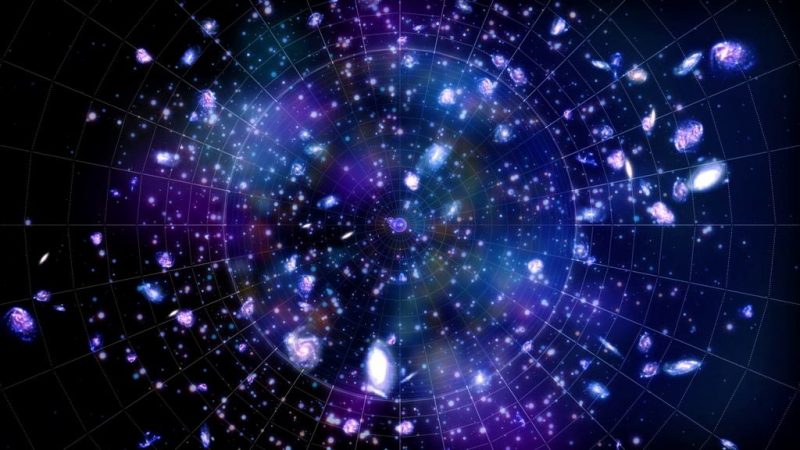
The Exotica Catalog will include “one of everything” of a wide range of known objects and phenomena in the universe. Image via Goddard Space Flight Center/ Space.com.
Yuri Milner, the founder of Breakthrough Initiatives, also said:
Breakthrough Listen has already greatly expanded the breadth and depth of its search. The publication of this catalog is a new and significant step for the program.
Pete Worden, executive director of Breakthrough Starshot, added:
When it comes to the search for intelligent life, it’s vital to have an open mind. Until we understand more about the forms another civilization and its technology could take, we should investigate all plausible targets. Cataloging them is the first step toward that goal.
No confirmed technosignatures have been found yet, but the new, expanded search is really just beginning. The universe is vast, so it’s logical that finding something conclusive, if it’s out there, might take a long time. The Exotica Catalog will help to narrow down the search to some of the most interesting candidates and locations, and of course, new ones are always been discovered as well. The guiding principle behind it is the concept of “survey breadth,” i.e., the diversity of objects observed during a program. This will help astronomers constrain the project’s focus to the most interesting or promising targets and weed out natural phenomena that could be mistaken for artificial, and vice-versa.

Brian Lacki of Breakthrough Listen and lead author of the new catalog. Image via CCAPP.
Last February, the National Radio Astronomy Observatory (NRAO) also announced an outline for new approaches to the question of alien intelligence, and how best to look for it. This was a big step away from the old SETI paradigm, and could now be referred to as SETI 2.0.
We don’t know what surprises the new catalog will yield, but it is an exciting venture that just may help scientists determine whether humanity has any intelligent companions out among the stars and galaxies.
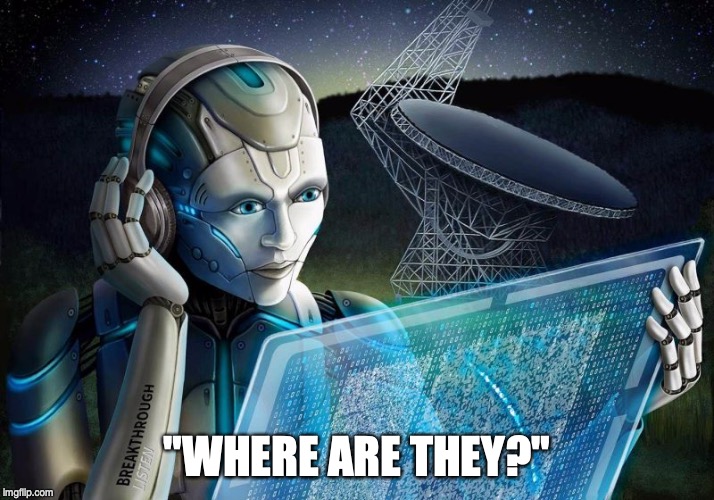
Are we alone? Breakthrough Listen’s new Exotica Catalog will help scientists search for technosignatures: signs of past or present intelligent extraterrestrial life. Image via Breakthrough Listen/ Danielle Futselaar/ SETI Institute.
Bottom line: The Breakthrough Listen project has released a new Exotica Catalog with over 700 “one of everything” targets in the universe.
Source: One of Everything: The Breakthrough Listen Exotica Catalog
from EarthSky https://ift.tt/3i317wf


The Green Bank Telescope in West Virginia is one of the telescopes used by Breakthrough Listen for SETI. Here, an artist has portrayed a signal from a Fast Radio Burst – or FRB – detected by the telescope. FRBs are one of the sorts of objects on the new Breakthrough Listen Exotica list. Image via UC Berkeley.
Are we alone in the universe? That’s one of the biggest, still unanswered questions facing humankind. Now, the Breakthrough Listen initiative has announced the release of a comprehensive Exotica catalog, listing over 700 objects and phenomena in the known universe of potential interest to scientists searching for technosignatures, that is, evidence of extraterrestrial intelligence beyond just the radio signals focused upon in traditional SETI.
Breakthrough Listen says the targets listed in its Exotica catalog will also be useful for the study of astrophysics in general.
A new paper detailing the creation of the list – officially called The Breakthrough Listen Exotic Target Catalog, or Exotica Catalog – was published as a preprint at arXiv on June 23, 2020.
As explained by Breakthrough Listen:
Breakthrough Listen to date has largely focused on the search for ‘life as we know it’ – including Earth-like planets around sun-like stars such as Kepler 160. But what if extraterrestrial intelligences are not like us, but are found in the frigid reaches of the outer solar system, the extreme gravity of neutron stars, the brilliant cores of active galaxies, or the hearts of the richest galaxy clusters? Now we’re announcing an expanded approach, targeting ‘one of everything’ in the universe.
The new Exotica Catalog includes over 700 distinct objects. It has an example of each type in our Prototype sample, extreme objects with record-breaking properties in our Superlative sample, and lingering mysteries in our Anomaly sample. A small Control sample rounds out the list with sky locations we do not expect to be special as a comparison.
With the Exotica catalog, we aim to answer many questions. Have we been looking in the wrong places? Might a few of the objects we think are natural actually be artificial? Could some natural phenomenon or problem with our instruments fool us into thinking we are looking at a signal from an intelligence? What can we learn by using the unique Breakthrough Listen backend to observe the natural world?

Graph depicting what kinds of target selections are included in the catalog. Image via Lacki et al./ arXiv.
The intention of the catalog is to include “one of everything” in the observable universe. It is the first catalog in recent years to cover the entire vast array of exotic phenomena, from distant galaxies to objects in our own solar system. The idea is that it will serve as a guide for researchers searching for evidence of extraterrestrial life, as well as studying natural astrophysical phenomena. Brian Lacki, a graduate student at Ohio State University and lead author of the new catalog, said in a statement:
Many discoveries in astronomy were not planned. Sometimes a major new discovery was missed when nobody was looking in the right place, because they believed nothing could be found there. This happened with exoplanets, which might have been detected before the 1990s if astronomers looked for solar systems very different than ours. Are we looking in the wrong places for technosignatures? The Exotica Catalog will help us answer that question.
The catalog is not just limited to SETI, though. My hope is that any program with a new capability may use the Exotica catalog as a shakedown cruise around the universe.

Artist’s concept of a Dyson sphere megastructure, one type of hypothesized alien technosignature. Image via SentientDevelopments.com.
While the catalog has over 700 listings, those listings are grouped into four main categories:
- Prototypes: a list containing at least one example of every known kind of celestial object (apart from those too transient to present realistic observation targets). Planets and moons, stars at every point of their life cycle, galaxies big and small, serene star clusters and blazing quasars, and more are all included in the list.
- Superlatives: objects with the most extreme properties. These include examples like the hottest planet, stars with unusually high or low metal content, the most distant quasar and fastest-spinning pulsar, and the densest galaxy.
- Anomalies: enigmatic targets whose behavior is currently not satisfactorily explained. For instance, the famous “Tabby’s Star” with its bizarre dimming behavior; ’Oumuamua, the interstellar object that passed near Earth in 2017; unexplained optical pulses that last mere nanoseconds; and stars with excess infrared radiation that could conceivably be explained as waste heat from alien megastructures.
- Control sample: a list of sources not expected to produce positive results.

Artist’s concept of a pulsar. When pulsars were first discovered, it was thought they might be artificial beacons, but they turned out to be a natural phenomenon. The new catalog will help to better differentiate between natural phenomena and actual artificial artifacts. Image via NASA/ Goddard Space Flight Center.
There is also a new classification system for anomalies and new plans for observations of some of these objects based on the catalog.
This catalog is an innovative and welcome addition to the overall SETI effort, as it broadens the focus to many other celestial objects and phenomena, while traditional SETI tended to search only for radio signals, and more recently, light or laser signals. Technosignatures are the new big thing in the search for intelligent extraterrestrial life. But even the search for those until now has focused primarily on looking for evidence of “life as we know it” around nearby stars. According to Andrew Siemion, leader of the Breakthrough Listen science team:
Technosignature searches to date have largely focused on the search for ‘life as we know it’: nearby stars, in particular those known to host planets with the potential for liquid water on their surfaces. The expanded search capabilities that Breakthrough Listen has made possible allow us to consider a much wider range of possible technology-laden environments.

The Exotica Catalog will include “one of everything” of a wide range of known objects and phenomena in the universe. Image via Goddard Space Flight Center/ Space.com.
Yuri Milner, the founder of Breakthrough Initiatives, also said:
Breakthrough Listen has already greatly expanded the breadth and depth of its search. The publication of this catalog is a new and significant step for the program.
Pete Worden, executive director of Breakthrough Starshot, added:
When it comes to the search for intelligent life, it’s vital to have an open mind. Until we understand more about the forms another civilization and its technology could take, we should investigate all plausible targets. Cataloging them is the first step toward that goal.
No confirmed technosignatures have been found yet, but the new, expanded search is really just beginning. The universe is vast, so it’s logical that finding something conclusive, if it’s out there, might take a long time. The Exotica Catalog will help to narrow down the search to some of the most interesting candidates and locations, and of course, new ones are always been discovered as well. The guiding principle behind it is the concept of “survey breadth,” i.e., the diversity of objects observed during a program. This will help astronomers constrain the project’s focus to the most interesting or promising targets and weed out natural phenomena that could be mistaken for artificial, and vice-versa.

Brian Lacki of Breakthrough Listen and lead author of the new catalog. Image via CCAPP.
Last February, the National Radio Astronomy Observatory (NRAO) also announced an outline for new approaches to the question of alien intelligence, and how best to look for it. This was a big step away from the old SETI paradigm, and could now be referred to as SETI 2.0.
We don’t know what surprises the new catalog will yield, but it is an exciting venture that just may help scientists determine whether humanity has any intelligent companions out among the stars and galaxies.

Are we alone? Breakthrough Listen’s new Exotica Catalog will help scientists search for technosignatures: signs of past or present intelligent extraterrestrial life. Image via Breakthrough Listen/ Danielle Futselaar/ SETI Institute.
Bottom line: The Breakthrough Listen project has released a new Exotica Catalog with over 700 “one of everything” targets in the universe.
Source: One of Everything: The Breakthrough Listen Exotica Catalog
from EarthSky https://ift.tt/3i317wf

Aucun commentaire:
Enregistrer un commentaire